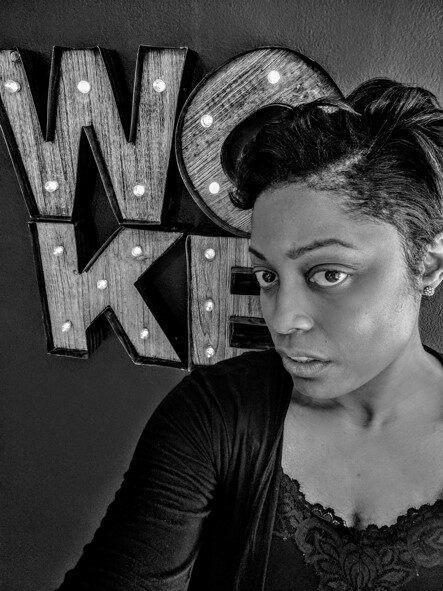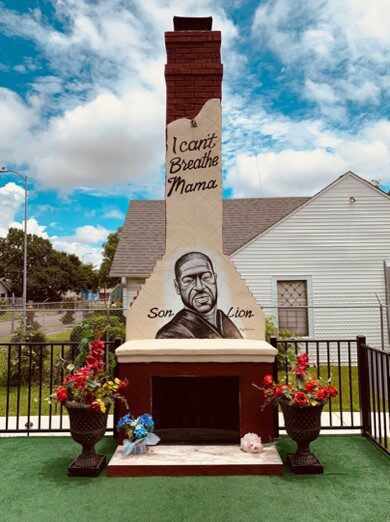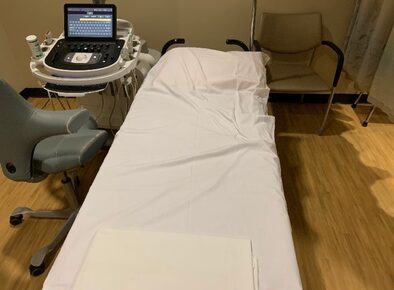Meditations: ON Race, Black Womanhood, and Writing
Kimberly Fain
Keywords: racial violence, disability, chronic pain, police brutality, black feminism
Categories: (De)Constructing Writing; Sick/Disabled Bodyminds during Sick/Disabling Times; Bearing the Weight of Racism through Anti-Racist Work and (Cross-)Racial Solidarity
Content warning: racial violence, police brutality
Abstract
When collaborating and working on multimodal texts, I’m belabored by injuries I’ve experienced over the years. Despite televised Covid and racial justice trauma, this writing threads together the struggle of composing texts from 2020-2022. Within these threaded writing experiences, I use the white gaze to symbolize the prioritization of white audience members and everyday white observers. When a text about black people centers the white gaze, whiteness is privileged over black writers’ need to preserve and nourish our minds, bodies, and spirits. Thus, America’s prioritization of the fears, concerns, and comforts of whites remains injurious to marginalized individuals. For this personal narrative, my injuries symbolize this burdensome carework and pervasive weight on my black female body.
Black Body

A photograph of the Art League Houston Exhibit How Do I Say Her Name?, which is inspired by deceased activist Sandra Bland's experience with police violence. Kimberly Fain is pictured in front of Prairie View professor and curator Ann Johnson's mixed media art "R U WOKE?". The light within the word WOKE symbolizes social consciousness.
Selfie By Kimberly Fain
To appease the white gaze, my black body must always be in motion. There’s grave pressure to remain in flux, to diminish white fears, white concerns, or white discomfort. To remain quiet or still negates a useful existence and appears to the white gaze as if I’m wasting time, space, or resources. When I’m trying to survive, thrive, or write, what a heavy burden this creates on my mind, my body, and my spirit. There is no quiet, no peace, no stillness to gather my thoughts, diagnose, or recover from societal damage. For the white gaze expects me to serve, console, and relinquish my own ingenuity for laborious and white-centered ideas and tasks. When decentering my stories, my health, my well-being, it’s hard to heal from repetitive injuries. What a burden the injurious white gaze is to my black body!
* * *
Covid Years
The Covid years have been rough. From the time America was stricken with Covid shutdowns in March 2020—prior to my Texas Tech University Summer 2020 graduation day—I feared my body was caving in. With support from friends, family, and my committee advisers, I powered through carpal tunnel syndrome and chronic back pain. Although my injuries stalled my writing at times, my mind was able to synthesize and rearrange information quick enough to produce a doctoral worthy dissertation: Black Feminist Rhetoric.
Since I work as a Visiting English Professor at my university, I stayed in the house writing, rewriting, revising, editing, and proofing. Like much of the world, during a 100-year pandemic, I watched the heroic masked black bodies pour into the Covid streets. Specters of generational trauma moved fluidly with non-black, yet still racialized bodies. Asian, Latinx, Middle Eastern, and Indigenous peoples have known their own tragic versions of racial trauma. Marching amongst them were white individuals. Boldly, they held signs and sacrificed their momentary comfort to visually proclaim Black Lives Mattered.
Despite the visual trauma of televised George Floyd and Breonna Taylor racial justice protests and the daily barrage of televised Covid deaths, I was determined to write through my carpal tunnel wrist pain and residual back pain. A year earlier, moving fast in my home, on my way to engage in early morning writing, I felt my feet slide down one step. After I fell backward, my entire body slid down four more steps. Even though I was able to walk away from the fall, my right shoulder became another source of injurious pain. Like the experience of many writers, sitting doesn’t help the joints and limbs. If you have carpal tunnel syndrome, a back injury, and shoulder pain like me, your pain increases with the incessant sitting down while writing.
* * *
Racial Violence
While I wrote through chronic pain flare-ups, I noticed various writers communicate their struggles of writing during the Covid lockdowns. Though I empathized with my fellow writers, I viewed the quieting of society a little differently. Quarantine became a refuge for my mind, body, and spirit to heal and reflect. During this solitude, I used writing as a mouthpiece for highlighting racial justice issues. I viewed my writing as a rhetorical response to the relentless exploitation of black bodies. By making society more aware of the harm caused by generational trauma, I hoped to persuade everyday Americans to reexamine themselves and engage in cultural healing. The ongoing George Floyd and Breonna Taylor protests emphasized the need for my racial justice work. To help students cope with Floyd’s death—in May 2020—JSTOR Daily compiled a reading list of formerly published works. All the featured articles were chosen to provide a context for America’s historical practice of institutionalized racism.
An article that I originally wrote—in September 2016—was organized under the heading: Video Documentation & Police Brutality: Ethical Considerations. The video documentation of Floyd’s murder sparked many discussions on the ethics of filming police brutality. When JSTOR Daily reprinted my online article, “Viral Black Death: Why We Must Watch Citizen Videos of Police Violence”—in their May 2020 “Institutionalized Racism: A Syllabus” publication—my work became part of the conversation again. I wrote this article in response to the repeated trauma of black death imagery. Above my article is a blurred picture of a gun. To reduce inflicting trauma on those who wish to not look or to look just once, the image is intentionally hazy. I defend Diamond Reynold’s choice “to record, air, and document her fiancé Philando Castile’s death.” Although there is black trauma in repeatedly engaging one’s eyes with those damning images, I have a red link to “‘Looking at One’s Self Through the Eyes of Others’: W. E. B. Du Bois’s Photographs for the 1900 Paris Exposition.” Pushing back against the concept of allowing others to define us, Du Bois resists the white gaze and emphasizes how we—as black people—must document and feature our own lives via our own images.
After writing about Du Bois’s resistance to the white gaze, I sought writing opportunities that would document and feature black lives from our perspective. When the anniversary of the 1921 Tulsa Race Massacre arose, I researched and wrote on the reckless destruction of black lives. By contributing to the scholarship previously written on the subject, I offered a black woman’s perspective on the obliteration of a historic black community. In May 2020, my article entitled “The Devastation of Black Wall Street” was reprinted for the second time. Also located in JSTOR Daily’s “Institutionalized Racism: A Syllabus,” the online essay features a haunting image from the Library of Congress. Black smoke billowed over the town as the Tulsa Race Massacre is perpetrated by white mob violence. Black Wall Street was another name for the prosperous black area also known as Oklahoma’s Greenwood District. A lovely voice from Curio reads the 14.49-minute essay. Her melodic tone stands in haunting contrast to the smoky black-and-white image. Despite the emotional pain I experienced while researching and writing for that essay, I am still pleased to be amongst a community of writers who responded to that tumultuous moment in time.
Later that summer, I was surprised to discover that my scholarship on race was known beyond America’s shores. In August 2020, I was commissioned by a London based publishing company, Elwin Street Productions, to write an essay on Colson Whitehead’s Underground Railroad. Considering I’m the first black person and black woman to write a book on this literary giant—Colson Whitehead: The Postracial Voice of Contemporary Literature—I was honored to continue my scholarship on Whitehead’s literary works. I was asked to write an essay for Elwin Street’s upcoming illustrated book, Literary Journeys. Since I remain perplexed by the white exploitation of black bodies, I emphasized how the talents and strengths of the black body were squandered. In other words, American capitalism constructed black labor and entertainment based on the needs, desires, and comforts of whites. In ante-bellum and post-bellum America, capitalistic endeavors led to the most egregious displays of American violence.
Despite my effort to resist the injurious white gaze, I was painfully aware of how my prolific writing was damaging my body. Wearing compression gloves was a safer and cheaper way to manage my carpal tunnel syndrome; I found Copper Fit gloves and rest eased much of my wrist pain. An online journal, The National Book Review, asked me to contribute further to the genre of black women’s literature. In February 2021, they published my piece entitled “LIST: 10 Books By Black Women Everyone Should Read for Black History Month.” At the top of the review, there is an image of a black woman on the cover of Octavia E. Butler’s Kindred. Toward the bottom of the book cover, there are black and white slave cabins. In this powerful novel, a modern-day black woman is transported back in time to heal her ancestral past. Butler’s science-fiction novel stresses a black woman’s perspective of sexism and racism. Via a black woman’s lens, generational trauma is framed differently. For my own healing, this list of great books by black women was exciting to write. Too often, our beauty and humanity are negated and demonized.
As part of my attempt to break the cycle of racial violence—in March 2021—I had the opportunity to mentor a college student from abroad. A young British black woman majoring in law contacted me. She was seeking an interview for a Warwick University iTunes Podcast Series Orders in Decay. Prior to the recorded portion of the Zoom interview, she wanted to know all about America. She wondered, if she traveled here, if she and her black women friends would be subjected to racial violence. By counseling her, like I would for any other college student, I assuaged her fears. Once you subtract those determined to torment others, America was a beautiful place with amazing people from all cultures.
After our unrecorded discussion of America’s racial past, we collaborated to complete the filming of our interview. I showed her how to capture the sound without the video. During post-production, the hour-long interview on the Tulsa Race Massacre was reduced to 20 minutes and 25 seconds of solid content. Like the recorded voice on Curio for “The Devastation of Black Wall Street,” her rhythmic British voice rang in contrast to the ubiquitous topic of American violence. With her narration, my commentary, and the jazz music in the background, the February 2022 podcast episode “The Horrors of Tulsa” captured how America strung a macabre racial love song.
* * *
The Knee

A photograph of the George Floyd Monument featuring his last words "I can't Breathe" and "Mama" above his image and the words "Son" and "Lion" on the sides of his neck in George Floyd Park, which is in Third Ward-Houston, Texas across from Floyd's former high school Jack Yates.
Photo By Kimberly Fain
The knee is an archetypal symbol for America’s racial tensions. During the American Anthem, quarterback Colin Kaepernick knelt on the football field for racial justice. In front of impassioned witnesses, convicted Minnesota killer cop pressed his oppressive knee on George Floyd’s neck. At George Floyd’s eulogy in Minneapolis, Reverend Al Sharpton called for America to get their knee off the necks of black Americans.
In July 2021, it was my knee; it wasn’t my wrists, my back, or my shoulder this time. As I prepared myself to accept the edits of my Peitho article, “Black Feminist Rhetoric in Beyoncé's Homecoming"—to my dismay—the cultural weight of emotional stress and the constant pressure to produce written product preyed on my body again. Due to Beyoncé’s cultural agency and black women empowerment messages, I felt compelled to finish this powerful multimodal project. So, despite the pain, all I could think of was, I better finish accepting these edits before I’m down for the count.
Even though Beyoncé has a wide range of diverse fans, now, I’m reflecting on my refusal to engage with the white gaze. Particularly, the white male gaze that are audience participants. In my rhetorical analysis, my nerves grew tense at the idea that I must even consider any audience other than the one Beyoncé intended: black people and black women.
In the process of articulating Beyoncé’s rhetorical intentions, I felt growing tension in my knee. For a week, I had been sitting and writing. Therefore, my knee had been progressively bothering me. After I finished reading over my article again, I tried to get up and walk. As I prepared for a second day of reviewing my Beyoncé article, I woke up with a swollen knee. There was a web of pain emanating from my swollen knee joint into my calf and thigh. Later that day, I went to my doctor’s office; I could hardly walk, and my leg would not fully extend. So, I limped to another room in the medical building to get bloodwork and get checked for bursitis.

A photograph of my empty emergency room bed in Houston, Texas.
Photo By Kimberly Fain
Once I finished checking in, I sat down and called my parents. I told my parents that the nurse pushed through orders to check for a blood clot, too. Since the skin stretched so tight on my leg, she thought it was best to check for multiple issues.
By this time, my emotions were jumping all over the place, I was almost crying. While I was getting my bloodwork, my husband was scheduling an appointment to check me out for a blood clot. Depending on how it looked to them, I would either check into the hospital that night or start taking blood thinners immediately. Fortunately, after hours of stressing out, there was no blood clot. Yet, after an x-ray, the technician discovered there was arthritis in my knee, and it had flared up badly.
So, as I move through this world, I plan to care more for myself and resist the injurious white gaze that says my emotional, mental, and physical labor is not enough. I will resist notions that my body must serve others to find worthiness and validity. I will resist the mammy burden forced upon my maternal ancestors’ shoulders. I will resist the capitalistic voices that say my worth is determined by my labor and entertainment value. Instead, I’ll preserve my mind, my body, and my spirit by writing for the black woman’s gaze and normalizing the centering of it.
Bio
Kimberly Fain, Ph.D., J.D. teaches literature and writing as a Visiting Professor at Texas Southern University. She has authored over 50 publications including essays, articles, reviews, chapters and three books: Colson Whitehead: The Postracial Voice of Contemporary Literature, Black Hollywood: From Butlers to Superheroes, the Changing Role of African American Men in the Movies, and African American Literature Anthology: Slavery, Liberation and Resistance.
